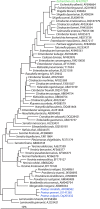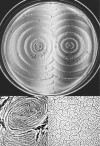Proteus spp. as Putative Gastrointestinal Pathogens
- PMID: 29899011
- PMCID: PMC6056842
- DOI: 10.1128/CMR.00085-17
Proteus spp. as Putative Gastrointestinal Pathogens
Abstract
Proteus species, members of the Enterobacteriaceae family, are usually considered commensals in the gut and are most commonly recognized clinically as a cause of urinary tract infections. However, the recent identification of Proteus spp. as potential pathogens in Crohn's disease recurrence after intestinal resection serves as a stimulus to examine their potential role as gut pathogens. Proteus species possess many virulence factors potentially relevant to gastrointestinal pathogenicity, including motility; adherence; the production of urease, hemolysins, and IgA proteases; and the ability to acquire antibiotic resistance. Gastrointestinal conditions that have been linked to Proteus include gastroenteritis (spontaneous and foodborne), nosocomial infections, appendicitis, colonization of devices such as nasogastric tubes, and Crohn's disease. The association of Proteus species with Crohn's disease was particularly strong. Proteus species are low-abundance commensals of the human gut that harbor significant pathogenic potential; further investigation is needed.
Keywords: Crohn's disease; Enterobacteriaceae; Proteus; bacteriology; gastrointestinal disease; infections; inflammatory bowel disease.
Copyright © 2018 American Society for Microbiology.
Figures







References
-
- Yatsunenko T, Rey FE, Manary MJ, Trehan I, Dominguez-Bello MG, Contreras M, Magris M, Hidalgo G, Baldassano RN, Anokhin AP, Heath AC, Warner B, Reeder J, Kuczynski J, Caporaso JG, Lozupone CA, Lauber C, Clemente JC, Knights D, Knight R, Gordon JI. 2012. Human gut microbiome viewed across age and geography. Nature 486:222–227. doi:10.1038/nature11053. - DOI - PMC - PubMed
-
- Mondot S, Lepage P, Seksik P, Allez M, Treton X, Bouhnik Y, Colombel JF, Leclerc M, Pochart P, Dore J, Marteau P, GETAID . 2016. Structural robustness of the gut mucosal microbiota is associated with Crohn's disease remission after surgery. Gut 65:954–962. doi:10.1136/gutjnl-2015-309184. - DOI - PMC - PubMed
-
- Penner JL. 2005. Genus XXIX. Proteus, p 745–753. In Brenner DJ, Krieg NR, Staley JT, Garrity GM (ed), Bergey's manual of systematic bacteriology, 2nd ed, vol 2 The Proteobacteria: part B, the Gammaproteobacteria. Lippincott Williams & Wilkins, Philadelphia, PA.
-
- Manos J, Belas R. 2006. The genera Proteus, Providencia, and Morganella, p 245–269. In Dworkin M, Falkow S, Rosenberg E, Schleifer K-H, Stackebrandt E (ed), The prokaryotes. Springer, New York, NY.
Publication types
MeSH terms
Substances
LinkOut - more resources
Full Text Sources
Other Literature Sources
Miscellaneous

